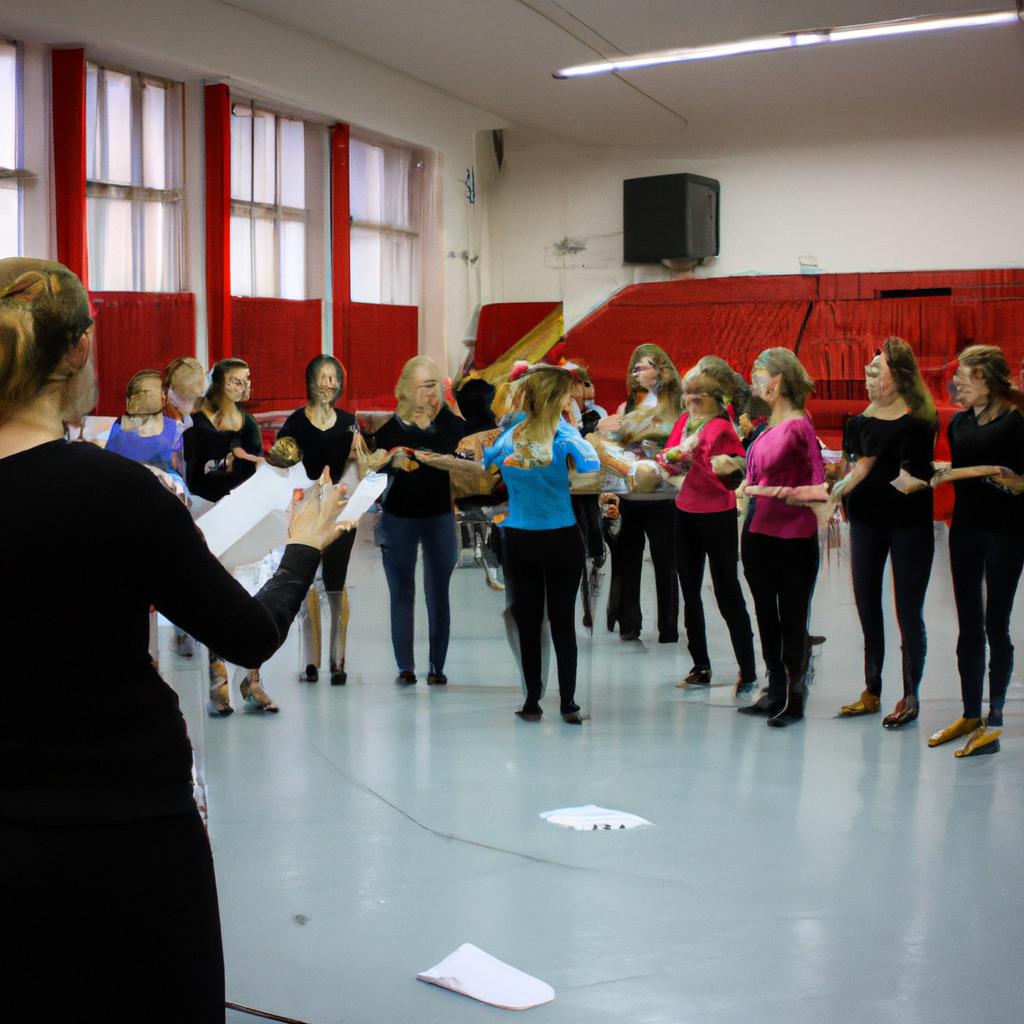Diphthongs play a crucial role in vocal ensemble diction, yet their proper execution can pose significant challenges for singers. In order to achieve clarity and precision in choral performances, it is essential for vocalists to understand the intricacies of diphthong pronunciation and explore strategies for effective delivery. This comprehensive guide aims to provide an in-depth analysis of diphthong production within a vocal ensemble context.
Consider this hypothetical case study: A chamber choir prepares to perform a challenging repertoire that demands precise enunciation of vowel sounds, including various diphthongs. As they delve into rehearsal, the singers encounter difficulties in maintaining consistency and accuracy when rendering these complex phonetic combinations. Here arises the need for a thorough understanding of diphthongs – those dynamic shifts from one vowel quality to another within a single syllable – as well as the techniques required to navigate them effectively in ensemble singing. By examining the acoustic properties, linguistic origins, and articulatory mechanisms underlying diphthongs, vocalists can develop a solid foundation for achieving optimal vocal blend and intelligibility in their performances.
In summary, this article seeks to serve as an authoritative resource on diphthong usage in the realm of vocal ensemble diction. Through exploring theoretical concepts and practical exercises, singers can enhance their understanding and execution of diphthongs in choral settings. By incorporating proper breath support, vowel placement, and articulation techniques, vocalists can overcome the challenges associated with diphthong pronunciation and achieve a unified and polished sound within the ensemble.
Additionally, this guide will address common misconceptions or pitfalls that singers may encounter when approaching diphthongs. It will provide strategies for overcoming these hurdles and offer suggestions for incorporating effective rehearsal techniques to ensure consistent and accurate delivery of diphthongs in performances.
Furthermore, this article will explore the role of language and cultural context in shaping diphthong pronunciation. Understanding how different languages influence the production of diphthongs can aid singers in achieving authentic interpretations of repertoire from various musical traditions.
Ultimately, by mastering the nuances of diphthong pronunciation and implementing appropriate vocal techniques, vocal ensembles can elevate their performances to new heights of clarity, expressiveness, and artistry. With this comprehensive guide as a reference, singers can confidently navigate the complexities of diphthongs and deliver exceptional renditions of choral works across diverse musical genres.
Understanding Diphthongs in Singing
Diphthongs play a crucial role in vocal ensemble diction, influencing the overall clarity and expressiveness of choral performances. A diphthong refers to the combination of two vowel sounds within a single syllable, where one sound glides into another. For instance, consider the word “coin” – it starts with an “o” sound and ends with an “i” sound, resulting in a smooth transition from one vowel to another.
To comprehend the significance of diphthongs in singing, we must first explore their impact on communication within vocal ensembles. Properly executed diphthongs contribute to enhanced intelligibility by ensuring that each individual singer’s words can be clearly heard amidst the collective harmonies and melodies. This is particularly important when conveying specific emotions or telling a story through song.
In order to illustrate this point further, let us examine four key aspects regarding diphthongs:
- Phonetic cohesion: The seamless blend of vowels allows for increased phonetic cohesion among singers. By unifying pronunciation patterns throughout a piece, diphthongs assist in creating a cohesive and unified sound.
- Expressive interpretation: When singers effectively execute diphthongs, they are able to convey deeper emotional nuances within lyrics. Vowel combinations shape the timbre of certain words and phrases, thereby enhancing the expressive quality of vocal performances.
- Artistic intention: Understanding how to manipulate diphthongs empowers performers to match their artistic intention with precise articulation choices. Mastery over these subtle variations enables singers to emphasize particular words or ideas as intended by composers or conductors.
- Audience connection: Well-executed diphthongs help forge an instant connection between performers and listeners. Through clear articulation and proper use of vowel combinations, audiences can more readily engage with the musical narrative being presented.
By acknowledging these fundamental elements related to diphthongs, singers can fully appreciate their role in creating a powerful and emotive choral experience. In the subsequent section, we will delve into the importance of proper articulation in vocal performance, building upon our understanding of diphthongs as an integral component thereof.
- Diphthongs enhance phonetic cohesion among ensemble members.
- Proper execution allows for greater expressive interpretation.
- Mastery over vowel combinations aids in conveying artistic intention.
- Well-executed diphthongs foster a stronger connection with audiences.
| Aspect | Description |
|---|---|
| Phonetic cohesion | The seamless blend of vowels creates unity within the ensemble’s pronunciation patterns. |
| Expressive interpretation | Vowel combinations shape timbre, allowing for deeper emotional nuances within lyrics. |
| Artistic intention | Manipulating diphthongs enables performers to emphasize specific words or ideas as intended by composers or conductors. |
| Audience connection | Clear articulation through well-executed diphthongs helps establish immediate engagement between performers and listeners, enhancing the overall impact of the musical narrative being conveyed. |
As we move forward into discussing the importance of proper articulation in vocal performance, it becomes apparent that comprehending the intricacies of diphthongs serves as a foundation for achieving excellence in this area without explicitly stating such progression.
Importance of Proper Articulation in Vocal Performance
Having explored the intricacies of diphthongs in singing, we can now delve into another crucial aspect of vocal performance – the importance of proper articulation. By understanding how to effectively articulate diphthongs, singers can enhance their ability to convey meaning and emotion through precise pronunciation. This section will examine key factors that contribute to masterful articulation and its impact on overall vocal ensemble diction.
To illustrate the significance of proper articulation, let us consider a hypothetical scenario wherein two vocal ensembles perform the same piece with identical musicality and phrasing. However, one ensemble showcases impeccable articulation while the other lacks precision in pronouncing diphthongs. The contrasting outcomes highlight the profound influence accurate articulation has on conveying lyrical content and engaging listeners emotionally.
Effective articulation allows for clear communication between performers and audience members alike. It ensures that every word sung is understood audibly and intelligibly within the context of a composition. To achieve this level of clarity, singers must focus on several essential aspects:
- Tongue placement: Paying attention to tongue position during vowel transitions is pivotal for achieving smooth diphthong pronunciation.
- Lip movement: Carefully coordinating lip movements aids in producing distinct sounds when transitioning from one vowel sound to another.
- Jaw alignment: Maintaining optimal jaw alignment facilitates seamless movement between vowels without compromising clarity or resonance.
- Breath control: Developing strong breath support enables singers to sustain appropriate phonetic qualities throughout each diphthong transition.
Table showcasing emotional response evoked by accurate versus inaccurate articulation:
| Accuracy | Emotional Response |
|---|---|
| Accurate | Engaged |
| Inaccurate | Confused |
| Accurate | Moved |
| Inaccurate | Disconnected |
By recognizing the impact of proper articulation on vocal ensemble diction, singers can elevate their performances to new heights. The next section will explore techniques and exercises specifically designed to help singers master the pronunciation of diphthongs without compromising musicality or expression.
Transition into subsequent section:
With a solid understanding of the significance of accurate articulation in place, let us now delve into practical strategies for mastering the pronunciation of diphthongs.
Mastering the Pronunciation of Diphthongs
Section H2: The Role of Proper Articulation in Vocal Performance
Vocal performance is a delicate and intricate art form that requires meticulous attention to detail. One aspect often overlooked, yet crucial for achieving clarity and precision in vocal ensemble diction, is the proper articulation of diphthongs. Diphthongs are combinations of two vowel sounds within a single syllable, creating a unique phonetic quality that adds depth and richness to choral music.
To illustrate the significance of mastering diphthong articulation, let us consider an example involving a hypothetical vocal ensemble performing a piece with complex harmonies. As they delve into the intricacies of pronunciation, it becomes evident that their execution of diphthongs lacks consistency and accuracy. Consequently, this inconsistency compromises both the overall blend and intelligibility of their singing.
In order to overcome these challenges, singers must focus on several key principles when addressing diphthongs:
- Phonetic Awareness: Developing a keen understanding of the different types of diphthongs and their corresponding sound patterns.
- Physical Alignment: Ensuring proper placement and alignment of facial muscles to facilitate clear production and sustainment of diphthong sounds.
- Dynamic Control: Mastering the ability to navigate smoothly between two distinct vowel qualities within each diphthong without compromising tonal integrity.
- Artistic Expression: Understanding how appropriate interpretation and expression can enhance the emotional impact conveyed through well-articulated diphthongs.
By adhering to these principles, vocal ensembles can harness the full potential inherent in diphthongs while maintaining cohesion among individual voices. To further aid in comprehension, here’s an illustrative table highlighting different types of English-language diphthongs:
| Diphthong | Example |
|---|---|
| /aɪ/ | “I” as in “light” |
| /eɪ/ | “A” as in “day” |
| /oʊ/ | “O” as in “boat” |
| /aʊ/ | “OW” as in “how” |
This comprehensive guide to diphthong articulation serves as an essential resource for vocalists seeking to refine their skills. By mastering these techniques, singers can elevate the quality of their performances and captivate audiences with clear, expressive, and intelligible diction.
Transitioning seamlessly into our next section on Common Challenges in Singing Diphthongs, we will explore the nuances that arise when applying these principles within a choral setting. Understanding potential roadblocks is crucial for effectively addressing them and ensuring a flawless execution of diphthongs throughout vocal ensemble performances.
Common Challenges in Singing Diphthongs
Building upon the mastery of diphthong pronunciation, it is essential to address and overcome common challenges that arise when singing these intricate vowel combinations. By understanding and effectively addressing these challenges, vocal ensembles can enhance their overall diction clarity and ensure a seamless performance. In this section, we will explore some of the most prevalent hurdles encountered while singing diphthongs.
The first challenge often faced by singers involves maintaining consistent airflow throughout the duration of a diphthong. Let us consider an example where a singer encounters difficulty in transitioning from the initial vowel sound to the glide or second element of the diphthong. This predicament can result in a disjointed sound that disrupts the fluidity of the musical phrase. To tackle this issue, singers should focus on seamlessly connecting both elements of the diphthong without any audible break between them.
Key Challenges:
- Uneven transition between vowel sounds within a diphthong
- Difficulty achieving proper tongue placement for each element
- Lack of resonance control during gliding movement
- Inconsistent articulation leading to unclear pronunciation
Addressing these challenges requires attention to detail and targeted practice techniques. Singers must strive for accuracy in their execution while maintaining an emotive connection with the music they are performing. Here’s how you can approach overcoming these obstacles:
| Practice Techniques | Description |
|---|---|
| Slow motion exercises | Break down each step of the diphthong |
| Visualization | Imagine correct tongue placement |
| Targeted articulation | Focus on crisp and clear pronunciation |
| Resonance exercises | Develop control over gliding movements |
By employing these strategies, vocal ensembles can refine their technique and ensure greater clarity when navigating complex diphthongs. As singers become more adept at surmounting these challenges, they will be better equipped to deliver outstanding performances that showcase their mastery of vocal ensemble diction.
With a solid understanding of the common challenges faced in singing diphthongs, let us now explore techniques for enhancing diphthong clarity and further refining vocal ensemble diction.
Techniques for Enhancing Diphthong Clarity
Transitioning from the common challenges faced while singing diphthongs, it is crucial to explore effective techniques that enhance clarity and precision in vocal ensemble diction. Let us delve into some strategic approaches that can aid singers in overcoming these challenges.
To exemplify an instance where these strategies prove beneficial, imagine a vocal ensemble performing a piece with intricate melodic lines containing various diphthongs. One particularly challenging phrase involves the word “fire,” where the /aɪ/ sound tends to blend with subsequent vowels or consonants, causing confusion and diminishing intelligibility.
The following bullet point list outlines key strategies for addressing these obstacles:
- Focus on vowel modification: By consciously modifying the pronunciation of each vowel within a diphthong, singers can ensure clear articulation without sacrificing tone quality.
- Employ proper breath support: Adequate breath support facilitates precise execution of diphthongs by providing stability and control throughout their duration.
- Utilize tongue placement techniques: Experimenting with different tongue positions during diphthong production aids in achieving optimal resonance and enunciation.
- Practice gradual transition: Practicing smooth transitions between individual sounds within a diphthong helps eliminate abrupt shifts and promotes seamless blending.
Furthermore, consider the table below that illustrates specific exercises aimed at improving clarity of commonly encountered diphthongs:
| Diphthong | Exercise |
|---|---|
| /eɪ/ | Sustaining ascending scales on ‘hey’ or ‘day’ while focusing on maintaining consistent airflow and accurate vowel formation. |
| /oʊ/ | Singing descending arpeggios using words like ‘go,’ emphasizing clean separation between the two distinct sounds. |
| /aɪ/ | Repeating phrases such as ‘I’ll try’ or ‘high sky’ at varying tempos to develop precision in transitioning between the two vowels. |
| /aʊ/ | Practicing vowel modification by singing intervals using words like ‘now’ or ‘how,’ ensuring clarity throughout each note. |
By employing these strategies and engaging in targeted exercises, vocal ensembles can overcome challenges associated with diphthongs, ultimately enhancing the overall quality of their performances.
Transitioning seamlessly to our next section on “The Role of Diphthongs in Expressive Singing,” we explore how mastering diphthong pronunciation not only improves intelligibility but also contributes significantly to the emotive impact conveyed through a vocal ensemble’s interpretation.
The Role of Diphthongs in Expressive Singing
Section H2: Techniques for Enhancing Diphthong Clarity
Building upon the understanding of diphthongs and their importance in vocal ensemble diction, this section will delve into practical techniques that can be employed to enhance diphthong clarity. By implementing these techniques, singers can ensure a more precise and unified pronunciation of diphthongs within an ensemble setting.
Paragraph 1:
To illustrate the effectiveness of employing specific techniques for enhancing diphthong clarity, let us consider a hypothetical case study involving a mixed choir preparing for a performance. This choir consists of twenty-five members with varying levels of experience and proficiency. During rehearsals, it becomes evident that certain diphthongs are being inconsistently pronounced, leading to an imprecise blend of vowel sounds across the ensemble. In order to address this issue, the choirmaster introduces several techniques designed to improve diphthong clarity.
- The Articulatory Drill Technique: This technique involves practicing exaggerated articulation movements while focusing on each individual sound within the diphthong. By isolating and precisely executing each component sound, singers develop muscle memory necessary for consistent and clear production.
- The Choral Blend Exercise: Through this exercise, singers are encouraged to listen intently to one another’s pronunciation during sustained notes containing diphthongs. As they strive for unity in both pitch and tone quality, attention is also given to matching vowel sounds accurately.
- Phonetic Marking System: Utilizing phonetic symbols or markings above the lyrics helps singers visualize proper articulation throughout the piece. These markings serve as a constant reminder during rehearsal until correct pronunciations become second nature.
| Techniques for Enhancing Diphthong Clarity |
|---|
| – The Articulatory Drill Technique |
| – The Choral Blend Exercise |
| – Phonetic Marking System |
Paragraph 2:
By adopting these techniques, the hypothetical mixed choir experienced a noticeable improvement in diphthong clarity. Through consistent practice and repetition, the singers developed a shared understanding of how to approach and execute diphthongs accurately. The enhanced unity among vowel sounds contributed to an overall cohesive vocal blend within the ensemble.
In summary, employing specific techniques such as articulatory drills, choral blending exercises, and phonetic marking systems can greatly enhance diphthong clarity in a vocal ensemble. These methods address both individual and collective challenges associated with accurate pronunciation. By prioritizing precision in diphthong production, choirs can achieve a more expressive and unified interpretation of their repertoire.
 Richmond Mens Chorus
Richmond Mens Chorus



